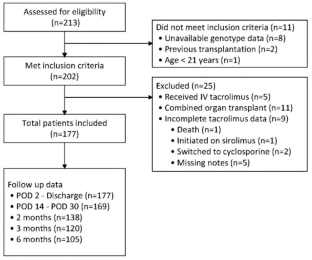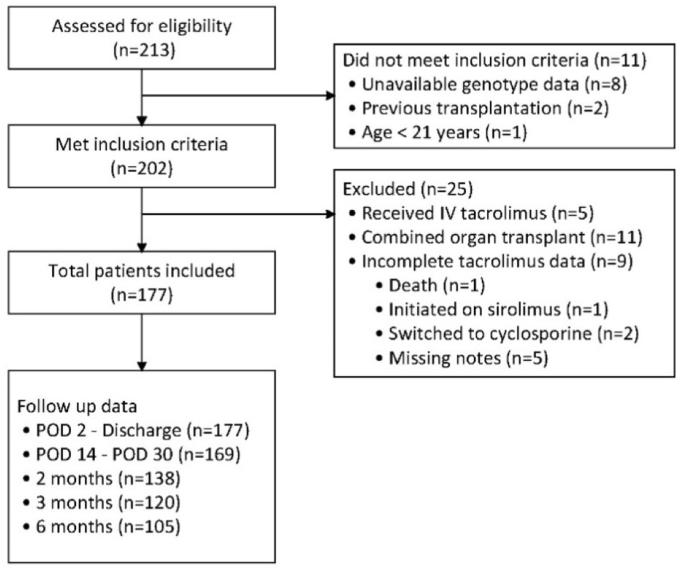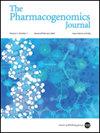Composite CYP3A (CYP3A4 and CYP3A5) phenotypes and influence on tacrolimus dose adjusted concentrations in adult heart transplant recipients
IF 2.9
3区 医学
Q2 GENETICS & HEREDITY
引用次数: 0
Abstract
CYP3A5 genetic variants are associated with tacrolimus metabolism. Controversy remains on whether CYP3A4 increased [*1B (rs2740574), *1 G (rs2242480)] and decreased function [*22 (rs35599367)] genetic variants provide additional information. This retrospective cohort study aims to address whether tacrolimus dose-adjusted trough concentrations differ between combined CYP3A (CYP3A5 and CYP3A4) phenotype groups. Heart transplanted patients (n = 177, between 2008 and 2020) were included and median age was 54 years old. Significant differences between CYP3A phenotype groups in tacrolimus dose-adjusted trough concentrations were found in the early postoperative period and continued to 6 months post-transplant. In CYP3A5 nonexpressers, carriers of CYP3A4*1B or *1 G variants (Group 3) compared to CYP3A4*1/*1 (Group 2) patients were found to have lower tacrolimus dose-adjusted trough concentrations at 2 months. In addition, significant differences were found among CYP3A phenotype groups in the dose at discharge and time to therapeutic range while time in therapeutic range was not significantly different. A combined CYP3A phenotype interpretation may provide more nuanced genotype-guided TAC dosing in heart transplant recipients.


成人心脏移植受者的复合 CYP3A(CYP3A4 和 CYP3A5)表型及其对他克莫司剂量调整浓度的影响。
CYP3A5 基因变异与他克莫司的代谢有关。关于 CYP3A4 功能增强[*1B (rs2740574), *1 G (rs2242480)]和功能减弱[*22 (rs35599367)]基因变异是否能提供更多信息,目前仍存在争议。这项回顾性队列研究旨在探讨他克莫司剂量调整谷浓度在 CYP3A(CYP3A5 和 CYP3A4)联合表型组之间是否存在差异。研究纳入了心脏移植患者(n = 177,2008 年至 2020 年),中位年龄为 54 岁。术后早期,CYP3A 表型组之间的他克莫司剂量调整后谷浓度存在显著差异,这种差异一直持续到移植术后 6 个月。在 CYP3A5 非表达者中,与 CYP3A4*1/*1 组(第 2 组)患者相比,CYP3A4*1B 或 *1 G 变体携带者(第 3 组)在 2 个月时的他克莫司剂量调整谷浓度较低。此外,CYP3A 表型组之间在出院时的剂量和达到治疗范围的时间上存在显著差异,而在治疗范围内的时间则无显著差异。对 CYP3A 表型的综合解释可为心脏移植受者提供更细致的基因型指导 TAC 剂量。
本文章由计算机程序翻译,如有差异,请以英文原文为准。
求助全文
约1分钟内获得全文
求助全文
来源期刊

Pharmacogenomics Journal
医学-药学
CiteScore
7.20
自引率
0.00%
发文量
35
审稿时长
6-12 weeks
期刊介绍:
The Pharmacogenomics Journal is a print and electronic journal, which is dedicated to the rapid publication of original research on pharmacogenomics and its clinical applications.
Key areas of coverage include:
Personalized medicine
Effects of genetic variability on drug toxicity and efficacy
Identification and functional characterization of polymorphisms relevant to drug action
Pharmacodynamic and pharmacokinetic variations and drug efficacy
Integration of new developments in the genome project and proteomics into clinical medicine, pharmacology, and therapeutics
Clinical applications of genomic science
Identification of novel genomic targets for drug development
Potential benefits of pharmacogenomics.
 求助内容:
求助内容: 应助结果提醒方式:
应助结果提醒方式:


